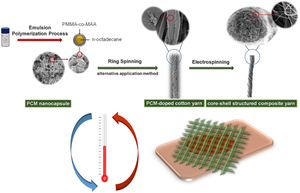Development of PCM-Loaded Composite Yarns for Enhanced Thermoregulation in Medical Textiles
Abstract
Thermo-regulating textiles incorporating Phase-Change Materials (PCMs) have emerged as innovative substances that automatically adapt to changes in environmental and body temperature. This paper presents an approach to develop a PCM-loaded composite yarn for potential use in medical textiles. Paraffin wax-based PCM nanocapsules were synthesized and integrated into cotton fibers during the ring spinning process. Subsequently, a composite core–shell-structured yarn was fabricated using electrospinning, comprising a cotton/PCM core and a poly (l-lactic acid) (PLLA)/PCM nanofibrous shell. Morphological analysis confirmed the successful formation of the core–shell structure and the uniform distribution of PCM nanocapsules within the fibers. The composite yarns exhibited reduced diameters with increasing PCM nanocapsule content. Thermal analysis revealed that the incorporation of PCMs resulted in decreased glass transition and cold crystallization temperatures of the PLLA nanofibers. Additionally, the presence of PCMs increased the crystallinity of PLLA fibers. According to the thermoregulation test results, the presence of PCM in its structure affected the heating and cooling behavior of the yarns. The composite yarns were further functionalized by incorporating Vancomycin as an antibiotic agent for medical dressing applications. This progress signifies an improved thermoregulation, offering potential applications in wound care and other medical settings.
Graphical Abstract


 求助内容:
求助内容: 应助结果提醒方式:
应助结果提醒方式:


